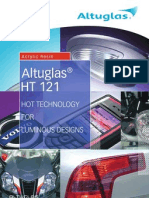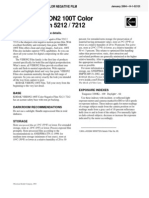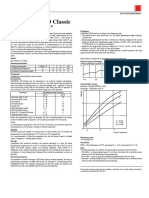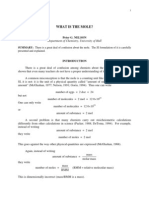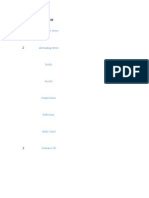Film Data Sheet T-669 Pack Film: Description
Film Data Sheet T-669 Pack Film: Description
Uploaded by
waltersx70Original Description:
Original Title
Copyright
Available Formats
Share this document
Did you find this document useful?
Is this content inappropriate?
Report this DocumentCopyright:
Available Formats
Film Data Sheet T-669 Pack Film: Description
Film Data Sheet T-669 Pack Film: Description
Uploaded by
waltersx70Copyright:
Available Formats
Description
Medium-contrast, medium-speed, daylight (5500K), (electronic
flash) balanced color print film with extended dynamic range.
Key Applications
Document or passport photography
Professional photography (test shots/proofing)
Close-up photography
Image Transfer
Emulsion Transfer
Electronic imaging print output
Compatible Hardware
Cameras or instruments with CB-103 Back or OEM CB-100
Back (these holders are supplied by medium format camera
manufacturers such as Mamiya, Hasselblad and Konica)
Polaroid Model 405 Film Holder
Special Treatment
None
Reciprocity Performance
The reciprocity characteristics of the film cause a color shift
towards blue-cyan when the exposure time is increased and a
color shift towards red-yellow when the exposure is decreased.
The film is balanced for average daylight (5500K) at
1
/125 of a
second (as well as for electronic flash units). Recommended
filtration at other exposure times and with other illuminants is
indicated on information packaged with the film.
Alternative Products
Polacolor ER (T-108) (ISO 80)
Polacolor Pro 100 (T-679) (ISO 100)
Polacolor 100 ID UV (ISO 100)
ProVivid (T-689) (ISO 100)
Film Data Sheet
T-669
Pack Film
Film Speed
ISO 80/DIN 20
Format
3
1
/4 x 4
1
/4 in. (8.5 x 10.8 cm)
Pack Film
Image Area
2
7
/8 x 3
3
/4 in. (7.3 x 9.5 cm)
Finish
Glossy or silk
Exposures per Unit
10 exposures per pack
2 packs per box
Development Time
60 seconds at 70F
&RORU ,QVWDQW 3DFN )LOP
3
1/4
x 4
1/4
inch
8.5 x 10.8 cm.
I
L
O
P
7\SH
Caution
This film uses a small amount of caustic paste. If any paste appears, avoid contact with skin, eyes and mouth
and keep away from children and animals. If you get some paste on your skin, wipe it off immediately, then
wash with water to avoid an alkali burn. If eye contact occurs, quickly wash the area with plenty of water and
see a doctor. Keep discarded materials away from children, animals, clothing and furniture.
Limited Warranty
See information on the film box.
Polaroid, Polacolor, and ProVivid are trademarks of Polaroid Corporation, Waltham, MA 02451 USA.
All other product names may be the property of their respective owners.
Processing time and temperature
For best results process at temperatures
above 60
o
F(16
o
C).
The information in this data sheet
represents the typical performance
of Polaroids T-88, T-108, T-669,
T-669S, T-559, T-559S, T-59 and
T-809 color films. Specific film lots
may vary.
Film Data Sheet
Technical Data
T-88, T-108, T-669 and T-669S (pack); T-559 and
T-559S (4x5 pack); T-59 (4x5 sheet) and T-809
(8x10 sheet) Instant Color Peel-Apart Films
D-Max: The density value for the
films darkest black.
D-Min: The lowest density value
that a film exhibits. In prints, the
whiteness of the brightest highlight,
relative to the unprocessed print.
Slope: The positive ratio of the log
E increments of the straight line
region of the curve, as determined
by the 1/4-3/4 increment method.
The slope of an H&D curve
indicates the overall contrast of a
film: low contrast slopes less than
1.10; medium contrast slopes from
1.10 to 1.70; high contrast slopes
greater than 1.70.
o
F
o
C
Time in
seconds
Exposure
adjustment
90 32 60 -1/2 stop
75 24 60 None
70 21 60 None
65 18 75 +1/2 stop
55 13 90 +1 stop
Recommended
speed (ISO)
80 / 20
o
Recommended
processing time
and
temperature
60 sec. at
70
o
F/21
o
C
Resolution
(1000:1)
9 line pairs/mm
Contrast medium
-3 -2 -1 0
0
1
2
3
Characteristic H&D curves for
normal development
Relative Log Exposure
S
a
m
p
l
e
D
e
n
s
i
t
y
H&D Curves
@ 70
o
F/21
o
C
Blue
Green
Red
-3 -2 -1 0
0
1
2
3
Characteristic H&D curves for
cold development
Relative Log Exposure
S
a
m
p
l
e
D
e
n
s
i
t
y
H&D Curves
@ 55
o
F/18
o
C
Blue
Green
Red
-3 -2 -1 0
0
1
2
3
Characteristic H&D curves for
hot development
Relative Log Exposure
S
a
m
p
l
e
D
e
n
s
i
t
y
H&D Curves
@ 95
o
F/35
o
C
Blue
Green
Red
Reciprocity law failure
A wide range of shutter speeds can be used without loss of film speed.
For longer exposure times, some exposure compensation is suggested.
Film Data Sheet
Technical Data
T-88, T-108, T-669 and T-669S (pack); T-559 and
T-559S (4x5 pack); T-59 (4x5 sheet) and T-809
(8x10 sheet) Instant Color Peel-Apart Films
Reciprocity: The ability of the film to respond in a constant manner
to a constant exposure (light intensity x time). Reciprocity failure
occurs during very long or very short exposures, requiring the
photographer to increase exposure.
Spectral Sensitivity: Shows the equivalent energy needed at each
wavelength in order to activate the emulsion so that it produces a
neutral density of .75.
* Recommended meter setting (compensates for reciprocity effects
and filter factors)
** With electronic flash
Exposure Time (seconds)
R
e
l
a
t
i
v
e
L
o
g
E
x
p
o
s
u
r
e
.001" .01" .0001" .1" 10" 1" 100"
Reciprocity Law Failure
0
.2
.4
.6
.8
1.0
1.2
1.4
1.6
1.8
Blue
Red
Green
S
p
e
c
t
r
a
l
S
e
n
s
i
t
i
v
i
t
y
Wavelength (nm)
0
1
10
1000
Spectral Sensitivity
350
100
Blue
Red
Green
650 600 550 500 450 400 700
Light
source
Indicated
exposure time
(sec.)
Filtration
Effective film
speed (ISO)*
Daylight
(5500
o
K)
1/3000**
1.1000**
1/125
1/3
1/8
1/4
1
10
CC10C
None
None
CC10R
CC30R
CC30R+CC10Y
CC40R+CC10Y
CC60R+CC10Y
64/19
80/20
80/20
64/19
50/18
40/17
25/15
10/11
Tungsten/Hal
ogen (3200-
3400
o
K)
1/8
1
5
10
30
CC60B
CC50B
CC40B
CC40B
CC30B
12/12
10/11
8/10
8/10
8/10
MP-4
Tungsten
(2800
o
K)
1/8
1
5
10
30
CC60B
CC50B
CC40B
CC40B
CC30B
12/12
10/11
8/10
8/10
8/10
Tungsten
microscope
illuminator
(3200
o
K)
0.125
1
5
10
CC50B
CC40B
CC30M
CC20M
12/12
12/12
12/12
12/12
Light sources and filters
You might also like
- Kappa CHL Book 5.40.02Document366 pagesKappa CHL Book 5.40.02nghiaNo ratings yet
- Latent Heat of Vaporization of EthanolDocument5 pagesLatent Heat of Vaporization of EthanolMel DyNo ratings yet
- Jotun Hardtop XP - Technical Data SheetDocument5 pagesJotun Hardtop XP - Technical Data Sheetamarican100% (1)
- Fomapan 200Document3 pagesFomapan 200Jovan Mac TireNo ratings yet
- Kester NP545 Solder Paste Lead Free en 20oct21 TBDocument5 pagesKester NP545 Solder Paste Lead Free en 20oct21 TBthang.tranNo ratings yet
- KODAK VISION3 500T Color Negative Film 5219 / 7219 / SO-219Document6 pagesKODAK VISION3 500T Color Negative Film 5219 / 7219 / SO-219Rodrigo del MoralNo ratings yet
- Fomapan 100Document3 pagesFomapan 100hxbxrtNo ratings yet
- Kodak EktarDocument6 pagesKodak EktarArchie Buensuceso FrescoNo ratings yet
- Ilford Pan 100 400 Manual EngDocument9 pagesIlford Pan 100 400 Manual Engalchy00No ratings yet
- KODAK TRI-X Reversal Film 7266Document6 pagesKODAK TRI-X Reversal Film 7266Alejandro FedezNo ratings yet
- Kodak Verichrome PanDocument4 pagesKodak Verichrome Panfoster747No ratings yet
- Kodak Verichrome 125 Technical PDFDocument4 pagesKodak Verichrome 125 Technical PDFcyberlimaNo ratings yet
- Kodak Professional Plus-X 125 Film / 125PX: Technical Data / Black-And-White FilmDocument10 pagesKodak Professional Plus-X 125 Film / 125PX: Technical Data / Black-And-White FilmGreg MartNo ratings yet
- AltuglasDocument8 pagesAltuglasLUCACOMP1974No ratings yet
- Ilford HP5 PlusDocument7 pagesIlford HP5 PlusbigzuruNo ratings yet
- Dupont™ Zytel 70G13Hs1L Nc010: Nylon ResinDocument6 pagesDupont™ Zytel 70G13Hs1L Nc010: Nylon ResinZaimari FerminNo ratings yet
- 5222 SSDocument2 pages5222 SSWilliamCondeNo ratings yet
- 4011 TDDocument2 pages4011 TDFernando HalaburaNo ratings yet
- KODAK VISION2 100T Color Negative Film 5212 / 7212Document8 pagesKODAK VISION2 100T Color Negative Film 5212 / 7212prashant_sehgalNo ratings yet
- Alpha: No-Clean Solder Paste (9098T)Document3 pagesAlpha: No-Clean Solder Paste (9098T)behzadNo ratings yet
- Eastman Color Negative Film 5247Document9 pagesEastman Color Negative Film 5247Ángel VNo ratings yet
- Photo Warehouse Film Development Chart Push Processing (B/W)Document1 pagePhoto Warehouse Film Development Chart Push Processing (B/W)danielkurniadiNo ratings yet
- Hardtop XP: Technical Data SheetDocument5 pagesHardtop XP: Technical Data Sheetadeoye_okunoyeNo ratings yet
- TDS - CHEMFLAKE CV - English (Uk) - Issued.13.04.200Document4 pagesTDS - CHEMFLAKE CV - English (Uk) - Issued.13.04.200wey5316No ratings yet
- KODAK VISION Expression 500T Color Negative Film / 5284, 7284Document12 pagesKODAK VISION Expression 500T Color Negative Film / 5284, 7284Omar García MNo ratings yet
- 0135AMDocument2 pages0135AMseacnliNo ratings yet
- Asia Clearedge Ep284 TdsDocument3 pagesAsia Clearedge Ep284 TdsDinesh KumarNo ratings yet
- Ilford HP5 Plus Spec SheetDocument7 pagesIlford HP5 Plus Spec SheetfalariotisNo ratings yet
- LG Color Monitor Flatron l1915sDocument26 pagesLG Color Monitor Flatron l1915ssontuyet82No ratings yet
- 2-8 Kodak Digital Imaging PlatesDocument6 pages2-8 Kodak Digital Imaging PlatesJayeshNo ratings yet
- Kalrez-0040 O Ring DataDocument2 pagesKalrez-0040 O Ring Datasai bhaskarNo ratings yet
- Kodak Ektachrome 100d Color Reversal Film 5294 7294 Datasheet enDocument4 pagesKodak Ektachrome 100d Color Reversal Film 5294 7294 Datasheet enRiad GhoneimNo ratings yet
- 105 Ta D411-350Document3 pages105 Ta D411-350isaacalvareztejanoNo ratings yet
- Ficha Tecnica TermoencogibleDocument33 pagesFicha Tecnica TermoencogibleNACION001No ratings yet
- Fomapan 100Document2 pagesFomapan 100alexandru_gheoNo ratings yet
- Topcon Catalogue IEV11Document40 pagesTopcon Catalogue IEV11Anonymous w5SJiLsNo ratings yet
- Polaroid 665fdsDocument5 pagesPolaroid 665fdsjbenscr100% (1)
- Penguard Express ZPDocument5 pagesPenguard Express ZPMustafa Al-YasseriNo ratings yet
- Dunlee OEM CatalogDocument20 pagesDunlee OEM CatalogErik JirikNo ratings yet
- CatalogDocument36 pagesCatalogBhurman Pratama PutraNo ratings yet
- Guide To Manual Processing of NDT Films: Technical Data / Non-Destructive TestingDocument6 pagesGuide To Manual Processing of NDT Films: Technical Data / Non-Destructive TestingcarlosNo ratings yet
- Fomapan 100Document2 pagesFomapan 10018igor99.99No ratings yet
- Hellma Best Seller 2012Document17 pagesHellma Best Seller 2012forfunNo ratings yet
- Ilford Push ProcessingDocument4 pagesIlford Push ProcessingMax BoNo ratings yet
- Philips BDP 3000 SMDocument43 pagesPhilips BDP 3000 SMJose Koc GongoraNo ratings yet
- Projet 6000 & 7000: Step Up To The Gold Standard in 3D Printing With Genuine Sla®Document4 pagesProjet 6000 & 7000: Step Up To The Gold Standard in 3D Printing With Genuine Sla®Ldi LerielNo ratings yet
- Optitemp HT 2 EP: DescriptionDocument2 pagesOptitemp HT 2 EP: DescriptionWirawan Adi Setya RNo ratings yet
- Syylex Glass DVD Accelerated Aging ReportDocument12 pagesSyylex Glass DVD Accelerated Aging ReportCS AMDNo ratings yet
- Toshiba Tdp-p8 DLP ProjectorDocument55 pagesToshiba Tdp-p8 DLP ProjectorSeema RoyNo ratings yet
- JOTUN Jotamastic 80Document5 pagesJOTUN Jotamastic 80Hafiz KamalNo ratings yet
- Lovibond PFX995/950 Series: Operators Instruction ManualDocument19 pagesLovibond PFX995/950 Series: Operators Instruction Manuallisda AsmidaNo ratings yet
- Stanyl Aplicacoes Gerais - DSMDocument40 pagesStanyl Aplicacoes Gerais - DSMRodrigo GhiroNo ratings yet
- CrastinSK603NC010 CompleteDocument6 pagesCrastinSK603NC010 Completerajcoep88No ratings yet
- Jotun Resist 86Document5 pagesJotun Resist 86Ansar AliNo ratings yet
- Dotp BasfDocument2 pagesDotp Basffake77No ratings yet
- Typical Properties: Halar Ectfe: Product Data SheetDocument4 pagesTypical Properties: Halar Ectfe: Product Data Sheetjim_corbet1211No ratings yet
- SCR 2Document237 pagesSCR 2euqehtbNo ratings yet
- The Fourth Terminal: Benefits of Body-Biasing Techniques for FDSOI Circuits and SystemsFrom EverandThe Fourth Terminal: Benefits of Body-Biasing Techniques for FDSOI Circuits and SystemsSylvain ClercNo ratings yet
- Modern Glass CharacterizationFrom EverandModern Glass CharacterizationMario AffatigatoNo ratings yet
- Reliability of Electronic ComponentsDocument7 pagesReliability of Electronic ComponentswreathbearerNo ratings yet
- Laboratory Manual Feb 2023Document38 pagesLaboratory Manual Feb 2023amirul ashrafNo ratings yet
- ENEL2PAH1 - Physical Electronics 1Document5 pagesENEL2PAH1 - Physical Electronics 1qanaqNo ratings yet
- ASME Codes - 2nd Edition PDFDocument59 pagesASME Codes - 2nd Edition PDFAlif Nur FirdausNo ratings yet
- Model Test Paper Physics CBSE Class XII 2023 - I Part IIDocument4 pagesModel Test Paper Physics CBSE Class XII 2023 - I Part IIAnanthakrishnan Tinneveli VNo ratings yet
- Acs Macromol 1c01182Document28 pagesAcs Macromol 1c01182Taranom SpNo ratings yet
- Arthur Bieser Solution Chap 2Document21 pagesArthur Bieser Solution Chap 2Sma Shamsi47% (19)
- 442HP Small and Large SizeDocument2 pages442HP Small and Large SizehufuentsNo ratings yet
- Me 12Document13 pagesMe 12dtwn59vf1No ratings yet
- CBSE Class 7 Science Heat Worksheets With Answers - Chapter 4Document2 pagesCBSE Class 7 Science Heat Worksheets With Answers - Chapter 4Harsh KumarNo ratings yet
- One Dimensional Heat FlowDocument4 pagesOne Dimensional Heat FlowSerial SpyNo ratings yet
- Paper Iem Journal 2012Document9 pagesPaper Iem Journal 2012Faraaz SamNo ratings yet
- Chemistry Depth StudyDocument22 pagesChemistry Depth StudygihanbajitheNo ratings yet
- ZOO302 HW1 Types of MicroscopeDocument3 pagesZOO302 HW1 Types of MicroscopeNini CioconNo ratings yet
- Super 220 Off Line Contact Cleaner PDFDocument2 pagesSuper 220 Off Line Contact Cleaner PDFamitzalteNo ratings yet
- Mole NelsonDocument7 pagesMole NelsonsergiochemNo ratings yet
- Materials Science Polymers Lab ReportDocument10 pagesMaterials Science Polymers Lab ReportRob Johnson100% (1)
- Tadi C: Ivan Supek and Theoretical Physics - .Document1 pageTadi C: Ivan Supek and Theoretical Physics - .Bio LesnerNo ratings yet
- Iso 3104-2023Document32 pagesIso 3104-2023Slda Ozkrc100% (1)
- MCQ 2009 Soln PDFDocument7 pagesMCQ 2009 Soln PDFSrinivas VenkataramanNo ratings yet
- 6 Mechanical Behaviour of MaterialsDocument44 pages6 Mechanical Behaviour of MaterialsArjun MahendraNo ratings yet
- HeatDocument11 pagesHeatMelissa M. Abansi-BautistaNo ratings yet
- 6.3 (A) Electrolysis of An Aqueous SolutionDocument18 pages6.3 (A) Electrolysis of An Aqueous SolutionFid AwanNo ratings yet
- Moren - MODULE 4 - Simple ConnectionsDocument14 pagesMoren - MODULE 4 - Simple ConnectionsJoshua Espanto MorenNo ratings yet
- Welding Defects PresentationDocument41 pagesWelding Defects PresentationAhsan AliNo ratings yet
- ASBEILA S30G 1-12hp Compressor R134a Refrigeration LBP Technical Datasheet Specs SpecificationDocument8 pagesASBEILA S30G 1-12hp Compressor R134a Refrigeration LBP Technical Datasheet Specs SpecificationRicardoHagelNo ratings yet
- Machine Design TerminologiesDocument14 pagesMachine Design TerminologiesJennie Vicenta50% (2)
- Chapter 15: Design of Concrete Section For TorsionDocument6 pagesChapter 15: Design of Concrete Section For TorsionAli AsgharNo ratings yet













